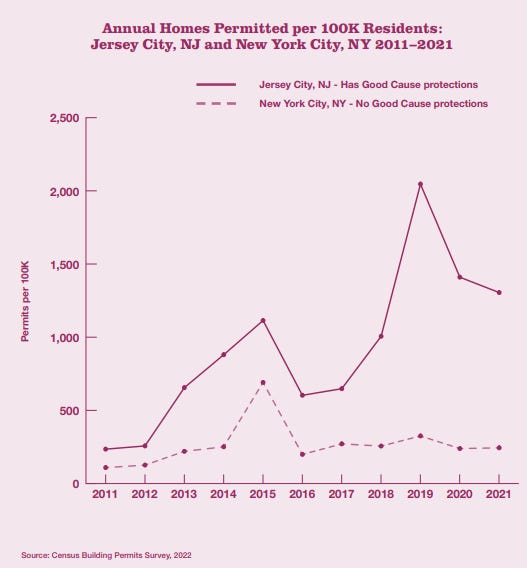A NY multifamily broker's response to Pratt Center's policy brief on Good Cause
I examine things that the Pratt piece fails to take into consideration - the omission of which serves to greatly weaken the claims of the authors
Response to Pratt Center’s Article on Good Cause Eviction:
As we approach the last two weeks of the legislative sessions in NY’s Senate and State Assembly, talk of Good Cause Eviction passing or not passing is bubbling up once more. Just this week, >1,000 tenant rights protestors gathered at the capitol building in Albany to demand the bill’s passing. Today, I write a response to the Community Service Society and the Pratt Center for Community Development’s piece “The Truth about GOOD CAUSE & Housing Supply, New York Can build & maintain housing while expanding tenants’ rights”
Though I think the piece comes from a good place, it also gets a lot of things wrong. The piece has recently been cited by news outlets to galvanize support for Good Cause Eviction (if you’re not aware what that is, time to get on it!) so it’s important to be aware of it. The authors cite 4 “myths” about what Good Cause would do, and then they clarify what would happen in reality. I find fault with pretty much every claim the authors make.
1) Myth – “Good Cause will lead to landlord disinvestment”
Anecdotally and empirically, there is evidence that suggests this is not a myth, but a reality. The 2019 rent regulations package in NY offer the perfect case study to examine. Comparing investors purchases of property before and after rent regulations passed offers strong evidence as to what investor response will likely be if Good Cause passes. The months preceding and the years following the June 15th, 2019, Housing Stability and Tenant Protection Act (HSTPA) saw a great reduction in multifamily investment sales. Investor appetites to buy & hold assets with increased controls were lower. The sales data supports this.
Before introducing new rent regulations
o 2016 – $15.3Bn in sales, 1,413 transactions
o 2017 – $8.9Bn in sales, 892 transactions
o 2018 – $13.5Bn in sales, 1,058 transactions
After introducing rent regulations
o 2019 – $8.8Bn in sales, 787 transactions
o 2020 – $5.4Bn in sales, 608 transactionso 2021 – $9.Bn in sales, 1,066 transactions
o 2022 – $11.4Bn in sales, 954 transactions (annualized figured from May 19th, 2022)
Source: CoStar multifamily building sales of >$1M price, with 5 or more units.
Key takeaway: there were about 29% more sales volume in the 3 years prior to 2019, and about 20% more individual transactions. The data confirms the anecdotes investors and brokers know by heart: disinvestment is real.
Note: From the outset of 2019, there was advanced talks of the pending rent regulations. Thanks to a democratic majority in the state assembly & senate and a blue governor, the market knew the passing of these laws could really happen. Transactions slowed.
Note: 2020 was peak Covid times, and the pandemic bore a significant impact on market activity that obviously didn’t exist prior so it shouldn’t be counted.
2) Myth – Good Cause “makes building/maintaining new housing, financially infeasible”
Positioning this claim as a myth is also wrong. The rent stabilized building stock helps us understand this. Evidence from the Rent Guidelines Board’s (RGB) survey shows that the costs to manage a NYC multifamily building have increased close to 4.5% this year, with heating costs skyrocketing near 20%, and insurance also going up to 10% YOY. In the last 7 years, the highest increases permissible for 1 year leases have been 1.5%, and 2.75% for 2 year leases. For most of that period, this worked since owners had mechanisms that allowed them to raise rents on those properties through renovations. Since 2019’s law passing, there is almost no other way to raise rents outside of RGB’s annual rent increase. Owners’ buildings costs have gone up 5% and their leases can only be renewed for +1.5% / +2.5% bumps for 1 and 2 year leases. That doesn’t add up.
As proof that it doesn’t add up, owners in NYC have at least 20,000 empty apartments that they refuse to rent because of the negative (and permanent) implications of pegging their rent lower than it could be on their P&L, per Jay Martin from CHIP. The Good Cause would create a very similar environment as rent stabilization does with limits on rent increases, and the inability to deny a tenant a lease, if he / she desires to stay. If the profit incentives are not in line, owners of multifamily won’t enter new apartments into service or build new ones.
Lastly, if this gets passed, owners whose current tenant mix is paying significantly lower than market rent will see their property equity scrubbed down because the buyer won’t have the ability to perform value add renovations on property without due difficulty. Think of the working-class mom & pop store and building owner with just one property. The impact of these rules could be very hard on these groups.
3) Myth – “Good Cause isn’t needed in new buildings because” median income of tenants is higher
This premise is misguided. Building a 10-unit apartment property is more nuanced than buying and renovating the same. Because there are a lot more components to account for, from when the land is purchased to when the newly built apartments can be rented, there are also a greater number of assumptions and contingencies than when buying existing property. The range of possible outcomes, from great success to horrible failure, is more varied than buying an existing property. Greater variance of outcomes means greater risk. To compensate for this risk, developers need outsized profits. You don’t risk quitting your job that you love, unless you think the reward of the next opportunity could take you to new heights. Putting a damper on future rent growth is not a deathblow, but many developers are going to think twice if new rules restrict their profit models. Moreover, as Basha Gerhards of REBNY points out, the introduction of Good Cause would call into question current affordable housing mixed income models where market rent units subsidize rent regulated, lower income apartments.
4) Myth – “Cities with Good Cause and other tenant protections don’t build enough new housing”
In other words, the myth is that, if good cause is passed, well it won’t constrain or disincentivize new housing development. I think this claim strikes at the heart of the debate in NYC on how to make living in NY more affordable for all. What I have issues with is the data the authors use to support their argument. I don’t think it holds water.
The piece use a graph that displays the number of new home permits passed in Jersey City, NJ per 100K people and compares it to the same number of new home permits filed in New York, NY from 2011-2021. Jersey City’s new permit count stays far above NYC levels, at least 50% greater and at times up to 4x. The conclusion drawn is that if NJ has Good Cause and it is building more than NY is building, then NY should be just fine if the bill is passes. The data issues here are pretty major:
Homes sales: number of permits for new homes developed is not a good way to measure investor demand for building new rental housing. New homes built will include a share of homes sold to home buyers to live in. Totally irrelevant to the discussion here of how rental building development economics are effected by rent regulation policy
The second problem with this data selection is that it doesn’t correct for the differences between the NY and NJ markets. This is a big problem, and it really weakens the comparison. Overall, Jersey City is more suburban and less dense than much of the Bronx, Brooklyn, Queens, and all of Manhattan. That means, there is a lot more construction of 1 and 2 family homes than of mid, or high-rise apartment buildings. One could argue there are less homes being built in NYC because there are more buildings, each containing enough space for 10 families to occupy. A better metric to contrast the two markets would be the number of multifamily units developed per 100K residents across Jersey City and NYC.
The multifamily industry has largely dismissed the Pratt Center piece as just wrong and nonsensical, but few have opined on why. My goal in writing this was to explain why the article lacks credibility. To say that new development would ultimately not be slowed by regulations is a big statement to make, and the evidence in the Pratt Center’s research piece certainly isn’t convincing in it’s argument




